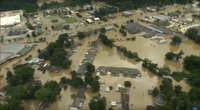What is climate change doing to the Netherlands?
A quarter of the Netherlands is below sea level. However, this is expected to increase further due to climate change. The land of dikes, dams and weirs is now preparing for this with far-sightedness.
Stan Fleerakker's fight against the climate crisis
Stan Fleerakkers, the terp farmer, stands in front of the yard and looks over his land. The land is quite a way below him, twenty feet to be exact. And at some point, maybe next year, maybe in 100 or 1000 years, this land around the farm will be a huge lake. For a while at least. "I was lucky," says Fleerakkers, the farmer, and he means it quite seriously. He is still young, but has long been weather-beaten. He lives here with his wife Yvonne, three children and 85 dairy cows.
The Fleerakkers have been living on their new farm since February this year, have a modern barn and a fully automatic milking machine. Everything looks fresh, almost virginal: the raised plateau on which her farm stands and the stable. It's damn hot, and up here you're mercilessly exposed to the sun - for now. The trees are small, but in a few years things will look different, then everything will be overgrown and more shady, says Fleerakkers. Because the mild climate here, on the banks of the Maas, the largest river in the Netherlands, will quickly lure nature out of its hiding place. "We were lucky," they both say.
Stan Fleerakkers is a terp farmer - meaning his farm is on a terp, an artificial mound of sand and earth. And he's Dutch - so by nature he belongs to a breed that has learned to live with the water. You have to deal with it all the time here. Similar to how a farmer in the Alps has to deal with lots of snow and precipices.
The water, when it comes one day, won't stay for long, at least that's what hydraulic engineers say. It will flow away again - maybe even within a few hours or days. This is what is planned in the Dutch government's major flood plan. But the corn, the corn, the grass, the harvest will then perhaps be destroyed. Stan Fleerakkers, the farmer, knows that, of course. And yet: He consciously accepted the risk. The risk of living in the middle of a polder is increased, i.e. in a retention area that will be used as an alternative zone for the water during the next big flood. Because if he did everything right, the Dutch government will compensate him for his loss.
Everything done right? Living on a platform in the middle of the classic flood area and then counting on additional income from your farm? Everyone knows that floods will probably come more frequently in the future, get higher and cause more damage. . .
The Netherlands largely consists of a huge four-river delta, over the centuries they have reclaimed more and more land from the sea. Today, 26 percent of the land area is below sea level, 59 percent is latently at risk of flooding, including those regions in which 80 percent of the gross national product is generated, be it through industry or agriculture. Flood protection, whether by the sea or on the many rivers, is essential for every Dutchman. And how you deal with it is crucial for the future of the country.
.jpg/picture-200?_=1806f614f08)
.jpg/picture-200?_=1806f613cf6)
.jpg/picture-200?_=1806f611405)
